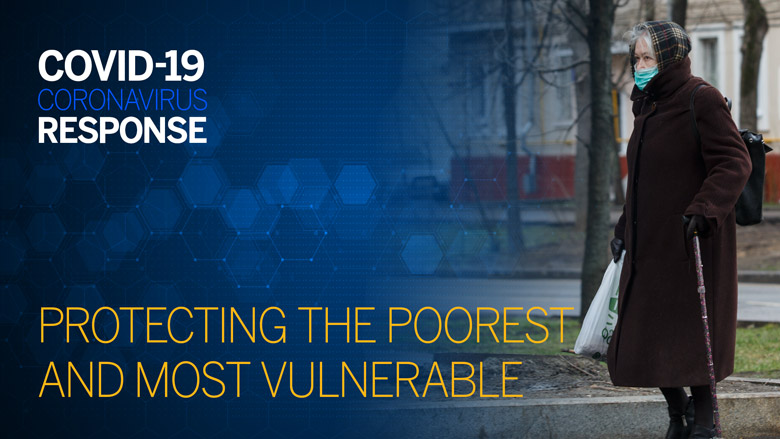
The potential saturation of hospitals with COVID-19 patients could exacerbate the existing disease burden and reduce the accessibility of health and social care services.
The suspension of mandatory school attendance could lead to a decline in student retention and quality of learning.
The effects of COVID-19 will be varied across several dimensions:
- People engaged in the retail, tourism, hospitality, and entertainment industries will be the most affected in the short run due to confinement measures and the inability to telework.
- Large metropolitan areas are more likely to experience the pandemic’s first economic impacts due to a concentration of these types of activities and to the higher population densities.
- The crisis will disproportionately affect vulnerable groups. Low-income families with children, which constitute over 70 percent of all low-income families, are more likely to struggle financially. Labor migrants (11–12 million per year), and in particular, those informally employed in the construction and service industries, are more likely to experience job loss. With imposed travel restrictions, many of these workers remain stranded, unable to return to their home countries but having little access to social protection measures or health care services in Russia.
- COVID-19 compromises the health status of the majority of the elderly (15 percent of Russia’s population was over 65 in 2018) and people with disabilities (8.2 percent of the population), and social isolation hampers their mental well-being. For the elderly and people with disabilities, self-isolation measures are also likely to contribute to reduced access to food, other necessities, medication, and health services. Over 24 percent of people with disabilities live alone and two-thirds are over the age of 55. Gender-based violence is also likely to increase in line with global trends as a result of the isolation measures.
These differential impacts across demographic groups, economic activities and location will render different poverty impacts across the population. Families with children could experience an increase in poverty rates of 2 or more percentage points, in contrast with other demographic groups that will experience an increase of poverty rates below one percentage point. The more concentrated is the fall in economic activities associated with retail, transport, hospitality and entertainment, and in metropolitan areas or large city centers, then the higher increases in poverty in some federal districts. Preliminary estimates indicate that central and north-western federal districts would face proportional increases in poverty that can be twice as large as other regions of the federation.
These impacts can be partly compensated by changes in social protection programs announced in January 2020 (including an extension in the coverage of the existing means-tested child allowances for first and second child, and the introduction of a new means-tested allowance for children aged 3 to 7) as well as the extensions in social assistance and social insurance announced in March and April (more on these below). These policies aim at families with children, the unemployed and the small and medium enterprises which are the groups expected to endure a more severe impact of the crisis, in the short term.
Short-term impacts could be followed by different medium- or long-term consequences, including non-recoverable losses, such as learning deficiencies at critical ages, aggravated chronic health conditions, permanent job losses, or small business bankruptcies. Smaller cities and rural areas may suffer the spread of the virus several weeks later and may have to confront the disease with fewer medical resources. Similarly, industries not initially affected, such as agriculture and manufacturing, could be affected in later stages if disruptions in internal logistics, international trade, or financial conditions make the resumption of full production difficult. Finally, fatigued health services may have to prepare for a future of increased demand due to delayed treatments or even a resurgence of virus infections.
The social protection policy to confront the pandemic needs to devise and implement measures that consider the different impacts—demographic, economic, locational, and intertemporal—of the crisis. A failure to provide social protection could lead to significant increases in poverty and vulnerability, societal tensions, and destabilizing unrest.
WHAT RUSSIA HAS DONE TO CONFRONT THESE CHALLENGES
Social assistance
- Automatic extension of social benefits without the need to submit any additional information or apply to the authorities in person
- Additional cash transfers for families with children (RUB 5,000 [US$64] a month) for each child under the age of three)
- Moratorium on cutting utility services for debts and fines for late payments from April 1 to December 31, 2020
Social insurance
- Increase in unemployment benefits from RUB 8,000 (US$103) to RUB 12,130 (US$157) a month
- Increase in compensation for employees on sick leave—at least one minimum wage RUB 12,130 (US$152) per month until December 31,2020
- Increase in social pensions (6.1 percent)
- Reduction in social insurance contributions for small and medium-sized businesses from 30 to 15 percent on the share of wages that is above the minimum wage
Regulatory measures
- Relieving labor migrants of work permit (“patent”) charges and automatically extending work permits
- Extending disability status and waiving the need for physical visits for new disability status applications until October 2020
WHAT ARE OTHER COUNTRIES DOING?
As of April 17, 2020, a total of 133 countries had introduced or adapted social protection and jobs programs in response to COVID-19. Among classes of interventions, social assistance or noncontributory transfers were the most widely used (352 measures), followed by actions in social insurance (134) and supply-side labor market programs (78).
Within social assistance, cash transfer programs remain the most widely used intervention by governments (34.2 percent) among total social protection measures.
Cash transfers represent 22 percent of monthly GDP per capita, ranging from 36 percent in low-income countries to half of that share (18 percent) in upper-middle-income countries. Regionally, North America and Europe and Central Asia have the most generous benefits (27 percent), almost double that of Latin America and the Caribbean (16 percent). Nearly 622 million beneficiaries are specifically being supported through COVID-related introductions, expansions, and adaptations of social assistance programs.
Within social insurance, paid sick leave and unemployment benefits are the most frequently adopted measures, with 29 percent and 28 percent, respectively. Sick leave is present in such countries as Algeria, El Salvador, Finland, and Lebanon. Unemployment benefits are reported, for example, in Romania and South Africa. Deferring or subsidizing social contributions is observed in Montenegro, Germany, and the Netherlands, among other countries.
Labor market interventions continue to be an important area of action, especially in the form of wage subsidies. Wage subsidies account for 61 percent of the global labor market portfolio, with programs being implemented in Jamaica, Kosovo, Malaysia, and Thailand. Activation measures (worker training) are also being considered in Bosnia and Herzegovina, China, and Romania, among other countries.
The World Bank Group is taking broad, fast action to help developing countries strengthen their pandemic response. The Europe and Central Asia region will be supported by US$486 million.
Social Assistance | |
Cash transfers (conditional and unconditional) | 47% |
Utility and financial obligation support (waiver/postponement) | 24% |
In-kind food/voucher schemes | 15% |
School meals | 5% |
Social pensions | 3% |
Childcare support | 3% |
Cash for work | 2% |
Universal one-off cash | 1% |
Social Insurance | |
Paid sick leave | 29% |
Unemployment benefits | 28% |
Social security contributions (waiver/subsidy) | 21% |
Pensions | 17% |
Health insurance support | 5% |
Labor Market | |
Wage subsidies | 61% |
Labor regulation adjustments | 19% |
Activation (training) measures | 16% |
Shorter work-time benefits | 4% |
WHAT MORE COULD BE DONE?
The World Bank has observed the following social protection and labor-related responses to the negative impacts of COVID-19 globally:
- Policies to increase benefits through existing social assistance (other countries are allocating on average 1 percent of GDP as targeted support to households and firms; the equivalent amount for Russia would be in the order of US$17 billion or RUB 1,343 billion)
- Policies to mitigate the impact of higher prices and unexpected medical costs
- Compensation to people for loss of income
- Policy options for strengthening income support for sick workers and their families
- Policies for employment retention and/or restoration
- An adjustment of social protection delivery systems to enable remote applications (e.g., by phone and online)
- Policy options to support workers and families who are caregivers
- Unemployment benefits for workers who have lost their jobs or self-employment
In the short term, additional measures to be taken in response to the COVID-19 pandemic may include:
- Introducing a temporary additional payment to pensioners with a basic pension benefit. Cash benefits should be adequately indexed to be able to act as automatic economic shock stabilizers as a response to the COVID-19 crisis.
- Increasing the capacity of social services to be able to carry the additional burden resulting from the crisis. This could include increased pay, the deployment of additional staff, and the provision of additional material resources such as protective gear and new protocols.
- Expanding measures to address immediate preventive needs at elderly residential care and other types of facilities that support vulnerable groups through direct financial support to vulnerable institutions such as orphanages and residential and health care facilities.
Mid-term measures may include:
- Strengthening the ability of the social protection system to respond to the crisis. The system needs to be modernized along two lines: the coverage of poor and non-poor households needs to be expanded and benefits need to be increased. Currently, the poor receive only 10 percent of social assistance transfers. When they are covered, they receive insufficient support to move them out of poverty.
- Strengthening citizen engagement mechanisms. The limited resources available and the government’s strictly enforced regulations to contain the epidemic are likely to contribute to a deterioration of public trust in the authorities. In response, measures to strengthen citizen engagement mechanisms and budget support to local governments, expanding on the advances already made in participatory budgeting practices, need to be designed. This should include strengthened mechanisms to address grievances, increased citizen oversight of social protection and social service delivery, and expanded opportunities for citizens and nongovernmental organizations to provide social services to vulnerable groups through social contracting and social entrepreneurship models. These measures would allow for better targeting of limited resources based on local needs, effectively leveraging non-state contributions alongside budget allocations and contributing to improved state-citizen dialogue and trust.
- Strengthening the focus on social inclusion. The needs of vulnerable groups should be systematically analyzed to ensure that immediate and longer-term policy responses are reaching them. In the immediate term, awareness materials need to be made accessible to the disabled, translated into the languages of minorities and labor migrants; options for extending health care coverage to temporary labor migrants need to be developed; and mid-term recovery efforts need to incorporate measures for social integration and inclusive service delivery.
RISKS AND PITFALLS TO AVOID
- Social protection/assistance measures should cover all vulnerable groups, including individuals who lack formal registration papers, such as homeless people and undocumented migrants.
- Local governments need to be empowered and provided with resources to design flexible measures at the local level to provide urgent assistance to the most vulnerable groups.
- Phone or online methods for effective remote payment of social assistance and enrollment applications should be introduced. This is essential to avoid the unintended consequence of large numbers of people gathering at welfare offices during the pandemic to receive additional social assistance.
Last Updated: May 04, 2020
MULTIMEDIA
Expert Answers: How Can We Help Countries Dealing with Coronavirus?
Experts
Renaud Seligmann
Director for Strategy and Operations, Planet Vice Presidency
